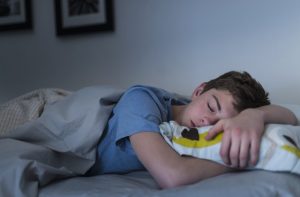Tip s for Anxious Children and Adolescents with Difficulties Sleeping by Dr. Magda Gonzales
s for Anxious Children and Adolescents with Difficulties Sleeping by Dr. Magda Gonzales
I think it is safe to say that most parents have heard one of the following statements from their fearful sleep deprived child or adolescent: “Mom and Dad can I sleep in your bed? “There are monsters in the closet.” “Can I have another hug and kiss and then I will go to sleep.” “I just need to send this one last text.” “I have to finish studying for my test tomorrow or I will fail.” There are just not enough hours in a day to fit in all of the tasks we set out to accomplish. Chase and Pincus (2011) found that 80-90% of youth with an anxiety disorder experience sleep-related problems. Furthermore, problems with sleep is also associated with higher severity levels of anxiety. What makes matters worse is that parents of anxious kids also walk around sleep deprived. This becomes a cyclical pattern that tends to affect the household and everyone in it.
How do you break the vicious cycle and return to normal sleeping patterns? Starting with sound sleep habits early in childhood is a great preventative measure for the adolescent years. Having a structured nighttime routine cues the body to prepare for sleep. It also gives the individual a sense of predictability which provides the child a sense of comfort and reduction in anxiety related to nighttime worries. In adolescents, it reduces morning problem-solving episodes that can be anxiety provoking such as what to wear and having all materials needed for school. One can use visuals and rewards as incentives to increase motivation for sticking with a structured routine. The basics for healthy sleep hygiene is to have them engage in a routine of 4-5 tasks 30 minutes before getting in the bed. These can consist of bathing, brushing teeth, putting on PJs, preparing clothes and book bag for the next day, and finally reading a book or praying before going into bed.
There are activities one can better manage throughout the day to improve sleep and these are as follows:

1. Daily exercise during the daylight hours.
2. Follow the recommended screen time parameters. Parents are advised to use passwords actively with devices, no TV in the bedroom, use reward systems to earn screen time, keep the charging station in parent’s bedroom, and stop using devices at least one hour before bed (and yes, that includes TV and phone use).
3. Parents model proper sleep hygiene and use of devices is also helpful in the learning process.
4. Create an ideal sleep environment that facilitates continued sleep: darkness (if needed, use a red light bulb as a night light), quiet or white noise machine, and temperature should be below 75 degrees.
5. Limit caffeine intake throughout the day.
6. No liquid or food intake 1-1.5 hours prior to bedtime.
7. Limit or avoid emotional conversations before bedtime.
When working with a mental health professional you will find that they will use measures to better identify the specific sleep problems (ie. falling asleep, staying asleep, etc). Some of these tools are: The Children’s Sleep Habit Questionnaire (CSHQ; Owens, Spirito, & McGuinn, 2000) and The Children Sleep Hygiene Scale (CSHS; Harsh, Easley, & LeBourgeois, 2002). Additional measures are also used to assess for an anxiety disorder. These measures are both self-reports and parental reports. These measures will let the therapist know what to target and thus which interventions would be most helpful. The use of Cognitive Behavioral Therapy (CBT) is clinically proven to best manage both sleep problems and anxiety related issues via the employment of protocols to change behaviors and skills building. Once the particular issue is identified then CBT protocols for sleep can be applied. In specific, CBT sleep protocols have been proven to help reduce sleep onset latency and improve sleep efficiency (Paine & Gradisar, 2011). CBT can also help with treating other disorder such as separation anxiety and generalized anxiety disorder which tend to affect sleep. Skills such as relaxation techniques, problem solving, exposure, and reframing thinking are impactful interventions for those individuals suffering from anxiety and sleep problems. Another area of focus in the use of CBT is learning ways to manage the environment and behaviors that are under stimulus control (ie the child is allowed to sleep in the bed with parents if sick so the child frequently presents as sick).
Remember that the treatment of anxiety and sleep problems ought to be approached in a collaborative manner. The therapist is there to teach skills and support the parents in continuously setting limits and helping their children or adolescent succeed in meeting their goals. Collaboratively working with parents on implementing sleep interventions and finding barriers to the implementation of those interventions can be the factor that leads to the success or failure of the treatment. It is important for the therapist to figure out with the family what their strengths and needs are, so that the treatment interventions are properly tailored for the family to succeed. The ultimate goal is for the family to get sufficient quality independent sleep.
References:
1. Chase, R.M. & Pincus, D.B. (2011). Sleep-Related Problems in Children and Adolescents with Anxiety Disorders. Behavioral Sleep Medicine, 9(4), 224-236.
2. Harsh, J. R., Easley, A., LeBourgeois, M. (2002). A Measure of Children’s Sleep Hygiene. Sleep, 25, A316-A317.
3. Owens JA, Spirito A, McGuinn M. The Children’s Sleep Habits Questionnaire (CSHQ): Psychometric properties of a survey instrument for school-aged children. Sleep. 2000 Dec 15;23(8):1043-51.
4. Paine, S.,& Gradisar, M. (2011). A randomised controlled trial of cognitive-behavior therapy for Behavioural Insomnia of Childhood in school-aged children. Behaviour Research and Therapy, 49, 379-388.


